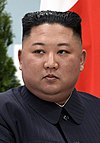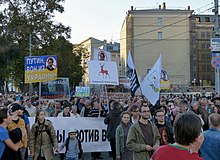최고지도자 (북한식 호칭)
Supreme Leader (North Korean title) |
|---|
| |
북한의 최고지도자(한국어: 최고령도자; MR: 최고령도자)는 조선노동당과 국가, 조선인민군의 실질적인 최고지도자입니다.국헌에 별도의 직함으로 기재된 것은 아니지만, 사실상 북한의 최고 지도자는 국무위원장입니다.마찬가지로 WPK 헌장에 따르면 WPK의 총서기는 노동당의 최고지도자입니다.과거 김정일 때는 WPK 총비서였던 국방위원장이 이 칭호를 받은 적이 있습니다.북한이 존재하기 이전의 국가의 첫 지도자는 1945년부터 1948년까지 한국의 북반부를 통치했던 소련에 의해 통제되었던 통치권자인 소비에트 시민청의 수장을 역임했던 Terenty Shtykov였습니다.[1]
최고지도자의 가장 우선적인 정치적 입장은 노동당의 지도부입니다.[2]이 직책은 1948년 조선민주주의인민공화국 수립부터 1966년까지 의장, 1966년부터 2012년까지 총무, 2012년부터 2016년까지 제1비서, 2016년부터 2021년까지 다시 의장, 2021년부터 다시 총무로 칭호를 받았습니다.선전원들은 1940년대 말부터 김일성을 최고지도자라고 부르기 시작했고 그 이후로 그 용어는 김정일과 김정은의 지위를 묘사하기 위해 사용되고 있습니다.그러나 김일성과 김정일은 지도자 임기 동안 각각 '위대한 지도자'(위대한 수령)와 '친애하는 지도자'(친애하는 령도자)로 불렸습니다.
목록.
| 사진. | 이름. | 제목 | 기간 | 재직기간 | 이념적 기여(들) |
|---|---|---|---|---|---|
 | 김일성 김일성 (1912–1994) | 조선민주주의인민공화국 내각 총리 | 1948년[3] 9월 9일 ~ 1972년[4] 12월 28일 | 1948년[3] 9월 9일 ~ 1994년[5] 7월 8일 | 주체 |
| WPK 의장 | 1949년[6] 6월 24일 ~ 1966년[7] 10월 12일 | ||||
| WPK 총무 | 1966년[7] 10월 12일 ~ 1994년[5] 7월 8일 | ||||
| 조선민주주의인민공화국의 대통령 | 1972년[8] 12월 28일 ~ 1994년[5] 7월 8일 | ||||
 | 김정일 김정일 (1941–2011) | 조선민주주의인민공화국 국방위원회 위원장 | 1993년[9] 4월 9일 ~ 2011년[10] 12월 17일 | 1994년[9] 7월 8일 ~ 2011년[10] 12월 17일 | 김일성주의 송운 십원칙 |
| WPK 총무 | 1997년[9] 10월 8일 ~ 2011년[10] 12월 17일 | ||||
 | 김정은 김정은 (1982년생) | 조선민주주의인민공화국 제1서기 | 2012년[11] 4월 11일 ~ 2016년[12] 5월 9일 | 2012년[11] 4월 11일 ~ 현재 | 김일성주의-김정일주의 병진 |
| 조선민주주의인민공화국 국방위원회 제1위원장 | 2012년[13] 4월 11일 ~ 2016년[14] 6월 29일 | ||||
| WPK 의장 | 2016년[15] 5월 9일 ~ 2021년[16] 1월 10일 | ||||
| 조선민주주의인민공화국 국무위원장 | 2016년[14] 6월 29일 ~ 현재 | ||||
| WPK 총무 | 2021년[17] 1월 10일 ~ 현재 |
- 대담한 자리는 북한의 유일한 집권 정당인 노동당에서 가장 높은 자리를 말합니다.
타임라인

참고 항목
- 북한의 영원한 지도자들
- 김씨가족
- 조선민주주의인민공화국 정부
- 북한의 인격 숭배
- 북한 지도자들의 거주지
- 파라마운트 리더, 중국의 동급 지도자.
참고문헌
- ^ "(24) Terenti Shtykov: The other ruler of nascent N. Korea". 25 January 2012.
- ^ "Supreme Leader Kim Jong Un Cuts Tape for Completion of Sunchon Phosphatic Fertilizer Factory". Kim Il Sung University. Korean Central News Agency (KCNA). 2 May 2020. Archived from the original on 17 May 2020. Retrieved 2 May 2020.
Kim Jong Un, chairman of the Workers' Party of Korea (WPK), chairman of the State Affairs Commission of the Democratic People's Republic of Korea and supreme commander of the armed forces of the DPRK, attended the ceremony.
- ^ a b "Background Note: North Korea". Bureau of East Asian and Pacific Affairs. United States Department of State. August 2008. Retrieved 18 September 2023.
- ^ 북한의 대통령직을 신설하고 북한의 총리직을 폐지한 북한 헌법의 제정을 바탕으로 한 것입니다.
- ^ a b c 김일성 사망일 기준
- ^ Defense Language Institute (July 1971). "Korean: Basic Course: Area Background" (PDF). U. S. Department of Health, Education and Welfare. p. 254. Retrieved 18 September 2023.
the Korean Workers Party, under the chairmanship of Kim Il-sung, was formed on June 24, 1949, as the result of a merger between the North Korean Workers Party and the South Korean Workers Party
- ^ a b Yang, Sŏng-chʻŏl (1999). The North and South Korean Political Aystems: A Comparative Analysis. Elizabeth, NJ: Hollym. p. 270.
The chairmanship post was replaced by the office of the general secretary at the Fourteenth Plenum of the WPK Fourth Central Committee (CC) on October 12, 1966, and Kim has been the WPK's general secretary ever since
- ^ 1972년 북한 국회의원 선거 결과를 기준으로
- ^ a b c "Timeline: Kim Jong-il". The Guardian. The Associated Press. 19 December 2011. Retrieved 18 September 2023.
- ^ a b c 김정일 사망일 기준
- ^ a b Sang-Hun, Choe (11 April 2012). "As Rocket Launching Nears, North Korea Continues Shift to New 'Supreme Leader'". The New York Times. Retrieved 18 September 2023.
The governing Workers' Party ... declared Mr. Kim "supreme leader" on Wednesday and awarded him the title of first secretary.
- ^ "North Korea leader Kim becomes chairman of ruling Workers' Party: NHK". Reuters. 9 May 2016. Archived from the original on 29 August 2017. Retrieved 6 January 2020.
Kim Jong Un, who has been first secretary of the ruling party, became chairman of the Workers' Party of Korea
- ^ Sang-Hun, Choe (11 April 2012). "As Rocket Launching Nears, North Korea Continues Shift to New 'Supreme Leader'". The New York Times. Retrieved 18 September 2023.
Per note at end of NYT article: 'An earlier version of this article incorrectly stated the day on which North Korea had elevated Kim Jong-un to chairman of the Workers' Party's central military commission and granted him membership in the Politburo and its presidium. It was on Wednesday (11 April), not Thursday (12 April).'
- ^ a b Sang-Hun, Choe (29 June 2016). "Kim Jong-un Takes an Additional Title in North Korea". The New York Times. Retrieved 18 September 2023.
The Assembly revised North Korea's Constitution to create what the state media called a Commission on State Affairs, with Mr. Kim as its chairman. It replaces the National Defense Commission.
- ^ Madden, Michael (20 May 2016). "Deciphering the 7th Party Congress: A Teaser for Greater Change?". 38 North. Archived from the original on 12 February 2021. Retrieved 12 February 2021.
The major organizational change announced at the 7th Party Congress was the reinstatement of the WPK chairmanship, to which Kim Jong Un was elected
- ^ Frank, Rüdiger (19 January 2021). "Key Results of The Eighth Party Congress in North Korea (Part 2 of 2)". 38 North. Archived from the original on 12 February 2021. Retrieved 12 February 2021.
Titles throughout all party levels were changed from "chairman" to three levels of "secretary".
- ^ Frank, Rüdiger (19 January 2021). "Key Results of The Eighth Party Congress in North Korea (Part 2 of 2)". 38 North. Archived from the original on 12 February 2021. Retrieved 12 February 2021.
Kim Jong Un was elected as general secretary of the party. This is remarkable, considering that on April 11, 2012, Kim Jong Il had been named the "eternal general secretary".


